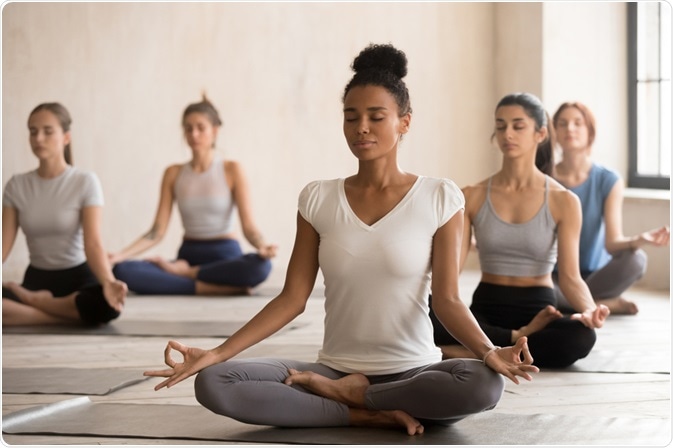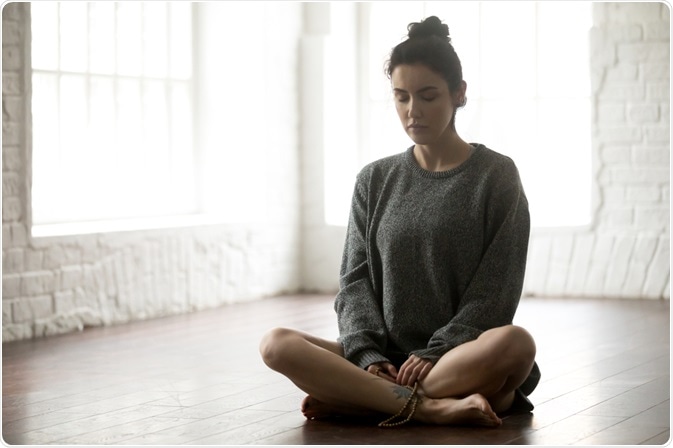Asana is the term used to describe both the setting and posture used by an individual practicing meditation. There are many different postures that can be practiced in the sitting, lying and standing positions; some of the most common postures are outlined below.
Lotus
The lotus position of meditation, sitting cross-legged with the feet on the opposing thighs, originates from ancient meditative practices in India. It is commonly used in many religious practices of meditation, including Buddhist, Hindu and Jain meditation.
 Lotus position. Image Credit: fizkes / Shutterstock.com
Lotus position. Image Credit: fizkes / Shutterstock.com
The position can be practiced by sitting down on the floor, placing one foot with the sole facing up on the opposite thigh, and placing the other foot on the other thigh in the same manner. When performed correctly, the heels should be close to the abdomen and the knees in contact with the ground. The spine should be straight and centered about the hips and the head and neck muscles relaxed.
Overall, the body should be relaxed and the position comfortable, without pain. Often, practitioners need to sit on a cushion to increase comfort and provide additional support to the spine.
The lotus position is beneficial as it is stable and can support the body for long periods of time, allowing the mind to relax into the practice of meditation. The physical position of the spine helps to relax the body and decrease muscular tension.
This position requires significant flexibility of the body, and not all individuals will be able to use this position when beginning to practice meditation. People with sciatica, sacral infections, and weak knees should avoid using this position.
Sukhasana
Also known as the easy pose or Burmese pose, the Sukhasan is similar to the traditional Lotus position with crossed legs to open the hips and lengthen the spine. However, this pose places less stress on the knees, which makes it easier for many individuals with physical limitations to practice.
It is easier to break the position and slump forward when in this position, disrupting the alignment of the spine. For this reason, it is not routinely recommended by all schools of meditation but is a suitable position for many individuals, particularly those that find the Lotus position difficult. The stability and spinal support can be increased with the use of cushions under the knees and buttocks.
 Sukhasana meditation pose. Image Credit: fizkes / Shutterstock.com
Sukhasana meditation pose. Image Credit: fizkes / Shutterstock.com
Kneeling
Kneeling is a position commonly associated with submission in obedience in society. It is in part for this reason, that kneeling is a preferred position for prayerful meditation in religions such as Christianity and Islam. It is also practiced as a position for meditation for other purposes and in secular practice, however.
Standing
Meditation can also be practiced in the standing position, although this is associated with greater issues of stability, which can disrupt the vacancy of the mind during meditation. Nonetheless, the benefits of standing meditation are evident for those that wish to practice in the position.
The arms can be held in various directions, by the sides of the torso or above the head. Most practitioners find that holding arms above the head is particularly uncomfortable at first, but can do this more easily as upper body strength is gained by continuing the practice.
Lying (Supine)
Lying face up in a comfortable position can also be used as a posture for meditation, known as supine position. This has a high degree of stability and allows the body of the individual to relax and focus on the mind.
All About Meditation Positions: 5 Perfect Meditation Postures For Beginners| Utsav 360
References
Further Reading
Last Updated: Jan 28, 2021